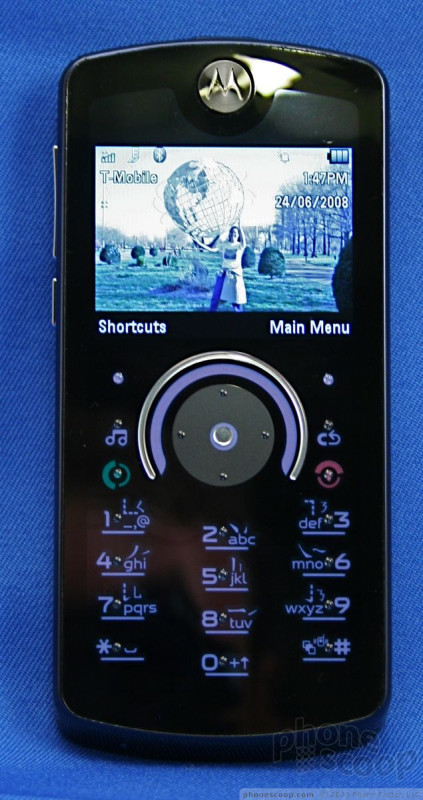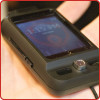Review: Motorola ROKR E8
The E8's most significant advancement is its compromise between a touch screen interface and a traditional D-pad. In sleep mode, the thin glass-covered candybar E8 is a near-seamless glossy black blank except for its silver 270-degree navigation arc. There are no visible keys. Only three vertical columns of pin point-like bumps on the lower half of the E8's glass surface indicate where the number and function keys will light up.
Wake the phone up, and a bright backlit touch-sensitive D-pad appears, easily readable even in direct sunlight. Push the dedicated music application musical note icon above the green "call" button and the D-pad disappears, replaced by music control keys. Put the phone into camera mode and camera-specific icons appear, including + and – zoom, play/review and a video icon to switch the phone into video mode.
In the middle of E8's face is its 270 degree FastScroll touch-sensitive arc, designed to operate like iPod's nav wheel. Nestled inside this silver arc is a more pedestrian up/down/left/right push circular navigation toggle.
Physically, the E8, with its wedged top and bottom is about a third wider, taller and thicker than the Nokia 5310 XpressMusic, another contender for best cell/music player, and occupies the same area as its slightly thicker cousin, the Motorola Z9.
On the right spine is a micro USB power charge jack covered for some reason with a tough-to-remove flap, and a rice-sized, three-position silver slide that is hard to operate without a finger nail. Slide the slide down to power up or power down the phone; pressing the red "end" icon, the usual power on/off control on other phones, does nothing except end an operation. Slide the slide up locks the phone's controls.
On the left spine is the slightly convex volume up/down toggle and the ModeShift action key which supposedly toggles through the phone, music and camera apps, but really just activates the camera. Centered on the top is another questionable flap-cover for the 3.5mm stereo headphone jack. On the rear is the 2 MP camera lens. There is no self-portrait mirror or flash.
As with many slim phones, you have to remove the rubberized back cover to insert a microSD card. Two problems: one, you also have to remove the battery (a problem in and of itself – we had to use a butter knife to pry it out), and, two, the back cover can be a bear to get back on correctly. Fortunately, if all goes well you'll only have to worry about this once.
That aforementioned rubberized back cover combined with the E8's slim profile makes the phone easy to grip and easy to operate with one hand and an extended thumb.









 CES 2008
CES 2008
 Motorola Announces E8 and Z10
Motorola Announces E8 and Z10
 Motorola ROKR E8 Details Emerge
Motorola ROKR E8 Details Emerge
 Unannounced Motorola Media Phone Spotted In Fergie Video
Unannounced Motorola Media Phone Spotted In Fergie Video
 Motorola ROKR E8
Motorola ROKR E8








